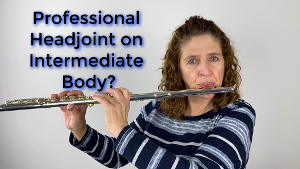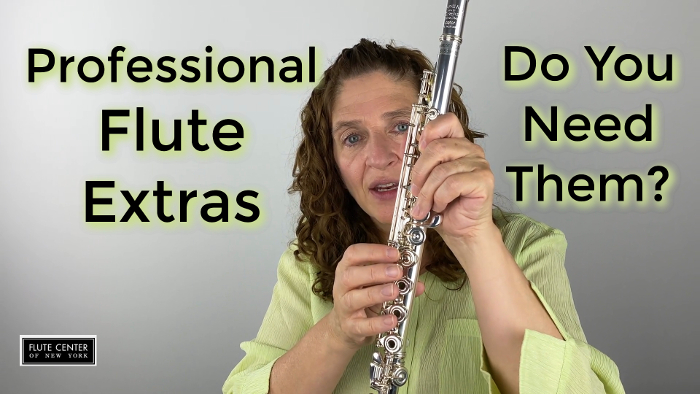Professional Model flutes offer extra options such as the C# Trill, the D# Roller, and the Split E Mechanism. But do you know what these options do for you? And do you really need them?
Over the years flute makers have come up with some add-ons to the basic flute construction that help solve some issue that flutists deal with. Some flute extras solve fingering issues, others help develop a better tone. When considering these options for your next flute, let me explain the pluses and minuses of these extras so that you can decide for yourself if you want to make this investment.
First let me tell you about my own instrument. My flute has no extras at all. I’ve been playing my flute for the last 20 years. For the most part, I’ve lived my entire professional flute life with no extras, and I don’t feel the lesser for it! I’ve not missed these extras. But as I have tried out some of these instruments that have these options, I can really see why you would want some of these added to your flute.
Now, let me just warn you that when you add an extra to your flute, it usually adds extra weight. When I compare my flute to one that has extras, I can feel the difference in weight. If weight is an issue for you, you want to think very carefully and make sure you’re trying out these instruments before you decide to purchase. Because if you have any kind of wrist problems or hand problems, the extra weight might not be worth it. If you are considering these extras, make sure that you trial them for the full 10 days to make sure your hands can handle that added weight.
Split E Mechanism
The first option I would like to talk about is called the split E mechanism. The split E mechanism is located next to the G key. (I think it should really be called a split G!) It is called the split E mechanism because it helps your 3rd octave E. Now this high E is very unstable, and it cracks. It cracks easily. Since I’ve never had a split E, I’ve worked hard at knowing where to put my airstream for stability and minimize the potential for cracks.
This extra key works great! You don’t need to put this key down yourself. It goes down with the normal combination of fingerings.
The downside to this addition is the added weight. For me the weight is significant. I’ve learned to play without this key. So, I don’t feel it is necessary. But it would be great. I think if you are just buying a flute to take to college or grad school, go with the split E. It will build your confidence when play that 3rd octave E.
C-sharp Trill
Option number two is the C-sharp trill. This trill key is located right next to the Bb lever key. Where normally there is one key, the C# trill key adds another lever. It’s called the C-sharp trill because you use it when you are trilling from a B to a C-sharp. The only way we can do this without the added C# trill key is by a very awkward movement. So, this makes it very smooth. Without this key that trill can be downright nasty. But we have all made it work.
There are other alternative trills that you can use this key for. But the B-C# is the main one.
Do you need it? No. But it is helpful. Again, this trill adds weight with the extra key. If you have hand problem, I wouldn’t recommend it.
Offset G
Another option for you is inline or offset G. Unlike the other extras, this one is not really an extra. It does not add any extra weight to the flute because all it means is a repositioning of the G key. All student flutes have offset G. The key sits out of line from the first two keys. It used to be that professional flutes only offered inline G. However, the prevailing thought these days is that the offset G is better for the health of the hand. My flute has always had inline G. So, I wouldn’t change it to offset at this stage of the game. My hands have learned how to play this way for many years and changing it now would be asking for trouble.
So, I recommend to all my students when they get a new flute that they get an offset G flute.
However, if you find the “perfect flute for you” except is has an inline G, do not panic. You will learn to adapt. This should not be a make-or-break issue.
Is it necessary? No, it a personal choice.
D-sharp Roller
The D-sharp roller is a small roller added to the D-sharp key. Its purpose is to help the pinky move back forth from the low C to D# easier. Sometimes when moving back and forth without this key, there is bit of a choppy movement and can cause a glitch. Adding the roller makes the movement smooth and easy.
This movement is more of an issue on intermediate flutes where the mechanisms are not as refined as on professional models. However, the D-sharp roller is a handy addition on the professional flute, that makes it easier for the pinky to move around and do it’s job more effectively.
Is this necessary. Not in any way. It is a convenience that can help in some circumstances. It does not add much extra weight, as it is just a redesign of the C-sharp key.
Heavy Wall or Standard Wall
I’ve talked about this option in another blog post, but I wanted to mention it here since it is an option for your new flute. There are actually 3 options for the thickness of the tube: Heavy wall which is .018, standard wall which is .016 and thin wall which .014. Each of these gives the flute a different sound. There is no good or bad it is only preference. If possible, you should try all 3 of these different walled flutes to see which works for you.
Head Joints
Head joints are another option that I’ve talked about in another blog. I do want to state here that the head joint that you are sent with your flute trial doesn’t have to be the headjoint you purchase. Here are some options to switch up with your head joint choice:
Solid silver
Solid silver with a gold (or platinum riser)
Solid silver with a gold lip plate
Gold head joint (varying carats)
Drawn or Soldered Tone Holes
Another extra or option that is offered on flutes are tone holes, whether they’re drawn or whether they’re soldered. Now, I’ve lived long enough that I’ve seen them sort of be a, I hate to say the word fad, but sort of a fad, because I remember way back when I was in high school, or maybe early college, and talking about soldered tone holes, and they were moving into drawn tone holes. And drawn tone holes were the biggest, best things since sliced bread, that that’s what every professional flute had. And then, somewhere along the way, I lost track of that and came back into thinking about a new flute. And so, I got into what is being offered today and found that soldered tone holes are in. Those are the ones that people are asking for, and they think, sometimes, are the better way to go. Well, let’s just talk about those.
A drawn tone hole means that the makers of the flute have taken the metal and drawn the tone hole up from the body of the instrument. Soldered tone holes are first formed, then soldered on to the flute. They’re made separately and soldered on. Each one gives a bit different sound. A soldered tone hole is going to darken the sound. A drawn tone hole is not going to offer quite as much resistance so it will lighten up your tone a little bit. Maybe a tiny bit extra weight in a soldered flute as opposed to the drawn tone holes, but I think it is negligible. The sound difference is really preference.
The Bottom Line
These are the flute extras that can be added to your professional model flute. When you are looking at a flute, go to Flute Center of New York and ask them about these different options. If weight is no problem, then try the split E and the C-sharp trill. They will help you in the long run for various things.
Let’s get to the bottom line. Are they necessary? Well, no, they’re not necessary. I’ve never had a split E. I’ve never had a C-sharp trill. I’ve only ever had standard wall. I haven’t had a D-sharp roller. I think my tone holes are soldered. I’ve pretty much always played with a gold riser. So that’s probably the only extra on my flute, but I felt like that was the tone that I wanted.
So, none of them are necessary. Nothing is. But do they add value to you as a flutist? Probably. They can make some things easier. It’d be nice to have a really stable high E, sometime, instead of working with it. But I’ve worked with it for the last 22 years, and so I can make my high E stable. It’s not really a problem, but I wouldn’t have to work so hard if I had that split E mechanism.
If you are looking for a new flute, check out these features and see if they are right for you.
Have fun!
DoctorFlute
Watch me demonstrate this:
Professional Flute Extras – Do You Need Them? FCNY Sponsored

Should You Put a Professional Headjoint on an Intermediate Body? FluteTips 170


I play a Brannen Orchestral with all of the extras (I need all the help I can get!). The split E is a blessing, but I have read that it makes the high F# less responsive. The only issue that I have with this flute is with this F#. But, I don’t know if it’s because of the split E or Cooper’s modifications.